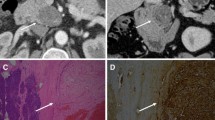Abstract
Neurilemmomas—or schwannomas—are rare soft tissue tumours involving peripheral nerve sheaths, usually found in the head and neck regions. They can infrequently originate within the tissues of the abdominal wall. Here, we present a case of symptomatic schwannoma of the abdominal wall in a 62-year-old woman referred for abdominal pain in the right iliac fossa. On physical examination, a 5–7-cm oval-shaped area of consolidation with regular borders and elastic consistence was palpable. Ultrasound examination of the abdomen revealed a hypoechogenic mass measuring 80–33–42 mm; subsequently, a CT scan confirmed the presence of a well-circumscribed mass, with small calcifications inside. Radical excision of the lesion under general anaesthesia was performed, and the histological examination was consistent with the diagnosis of “ancient” schwannoma. The patient was discharged on the second postoperative day, and, at a clinical check 1 month postoperation, she reported no recurrence of abdominal pain and had an improved quality of life. Schwannomas have a good prognosis overall, with malignant degeneration being very rare. Local recurrence is plausible only if non-radical resection of the primitive tumour occurs. This is the second case ever reported, to our knowledge, of symptomatic schwannoma of the abdominal wall. We advocate surgical removal of the tumour when it presents as a cause of abdominal pain, ensuring that a radical excision is performed due to the possibility—though rare—of malignant transformation or recurrence. This offers the possibility of total regression of symptoms through surgical therapy.
Similar content being viewed by others
Avoid common mistakes on your manuscript.
Introduction
Neurilemmomas—or schwannomas—are rare soft tissue tumours involving peripheral nerve sheaths.1 They usually arise from the head and neck regions; infrequently, they can originate within the tissues of the abdominal wall. When degenerative features tend to be predominant in a specimen of schwannoma, the adjective “ancient” is added to the definition.2 Here, we present the second case ever reported, to our knowledge, of symptomatic schwannoma of the abdominal wall.
Case Presentation
A 62-year-old woman was admitted to our institution for the evaluation of a mass in the right iliac fossa causing an enduring abdominal pain. The patient presented with the following comorbidities: visceral class I obesity (BMI 30.4 kg/m2), arterial hypertension, hypercholesterolemia, and asymptomatic sigmoid colon diverticulosis. Her surgical history encompassed a tonsillectomy at the age of 10 and an appendectomy at the age of 32. At the time of our clinical assessment, the patient complained of a well-localised abdominal pain, described as continuous, in the region of her right iliac fossa, near to the anterior superior iliac spine. The pain was exacerbated during trunk flexion-extension movements; it had no correlation with meals or bowel movements and was radiated to the ipsilateral lumbar region. On physical examination, there were no signs of peritoneal irritation; despite the subcutaneous layer thickness, a 5–7-cm oval-shaped area of consolidation with regular borders was palpable. Other findings, both on physical examination and on general chemistry tests, were unremarkable, including no elevation in neoplastic markers. The CT scan had revealed the presence of a well-circumscribed mass located beneath the muscular layer of the abdominal wall, with small calcifications inside (Figs. 1, 2a–c). The lesion showed little contrast enhancement (maximum density of 68 Hounsfield units in late phase). Given the symptoms described by the patient, we proceeded to the radical excision of the lesion under general anaesthesia. The mass showed no connection with the parietal peritoneum, exclusively involving the musculo-fascial layer of the abdominal wall. A histological examination of the surgical specimen revealed many features that were consistent with the diagnosis of “ancient” schwannoma (Fig. 2d). The patient was discharged on the second postoperative day after an uneventful postoperative period. Hospital visits were scheduled at 1 week and 1 month after surgery: the patient reported no recurrence of abdominal pain, with an improved quality of life.
Discussion
In literature, to date, only five cases of abdominal wall schwannomas were described, all of which are relatively recent: among these, only one case,3 depicts a small abdominal wall schwannoma causing a well-localised left lower quadrant abdominal pain in a 57-year-old woman. In our case, we believe that visceral obesity and the patient’s perception of pain as a symptomatic remnant of her old appendectomy could have allowed the tumour to grow unnoticeably over time. Schwannomas have a good prognosis overall, with malignant degeneration being very rare. Local recurrence is plausible only if non-radical resection of the primitive tumour occurs. Although the authors of the first asymptomatic case of schwannoma of the abdominal wall suggest a conservative approach to these kinds of lesions, we advocate the surgical removal of the tumour when it presents as a cause of abdominal pain, ensuring that a radical excision is performed given the possibility—though rare—of malignant transformation or recurrence.
References
Fletcher CDM, Bridge JA, Hogendoorn PCW, Mertens F. World Health Organization classification of tumours of soft tissue and bone, 4th edn. Lyon: IARC Press, 2013
Dodd LG, Marom EM, Dash RC, Matthews MR et al. Fine-Needle Aspiration Cytology of “Ancient” Schwannoma. Diagnostic Cytopathology 1999, 20(5):307–311
Balzarotti R, Rondelli F, Barizzi J, Cartolari R. Symptomatic schwannoma of the abdominal wall: A case report and review of the literature. Oncology Letters 2015 ;9(3):1095-1098
Author information
Authors and Affiliations
Corresponding author
Ethics declarations
We declare that:
1) The paper has not been previously published and is not under consideration by another Journal.
2) All authors have made a substantial contribution to the information or material submitted for publication.
3) All authors have read and approved the final manuscript.
4) All authors agreed to be accountable for all aspect of the work.
5) All authors have no substantial direct or indirect commercial financial incentive associated with publishing the manuscript.
Rights and permissions
About this article
Cite this article
Ginesu, G.C., Puledda, M., Feo, C.F. et al. Abdominal Wall Schwannoma. J Gastrointest Surg 20, 1781–1783 (2016). https://doi.org/10.1007/s11605-016-3164-5
Received:
Accepted:
Published:
Issue Date:
DOI: https://doi.org/10.1007/s11605-016-3164-5






